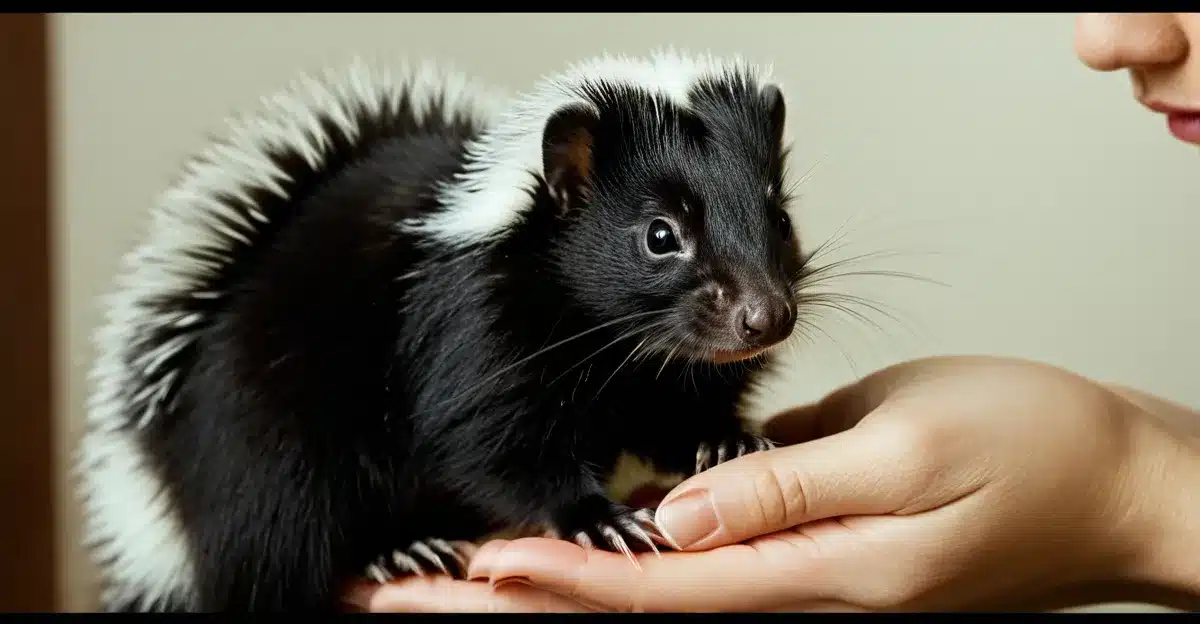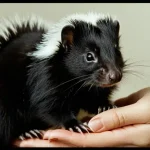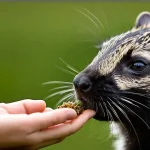Legal Requirements and Considerations
Navigating pet skunk legality starts with understanding your state and local laws. Many regions have specific skunk ownership laws that regulate or prohibit owning skunks as pets. Always research these restrictions closely, as they can vary widely—even between neighboring states or cities.
Most places that allow pet skunks require permitting or licensing. This process typically involves applying for a permit through a wildlife or animal control agency, which ensures you understand and meet the necessary conditions for responsible skunk ownership. Violating these pet skunk regulations can result in fines or confiscation of the animal.
Additional reading : What are the benefits of adopting a UK-native animal as a pet?
Ethical sourcing is another critical consideration. Seek reputable breeders or wildlife rehabilitators who comply with legal standards and treat skunks humanely. Responsible pet skunk ownership means avoiding illegal captures or trafficking, which harm wild populations and can lead to legal consequences.
In summary, fully familiarize yourself with your area’s specific skunk ownership laws, secure any required permits, and prioritize ethical breeder selection. This will help you stay within legal boundaries and provide a safe, ethical environment for your pet skunk.
This might interest you : How can you safely introduce a new pet rat to your home?
Home Preparation and Skunk-Proofing
Creating a safe environment for skunks begins with careful home preparation. Providing suitable pet skunk housing is essential; this should be a secure, comfortable space that mimics their natural habitat while preventing escape. Choose an enclosure with sturdy materials, tight seams, and secure locks to deter any attempts to break free.
Skunk-proofing your home involves protecting valuable household items and minimizing hazards. Cover or remove electrical cords and ensure that toxic plants or chemicals are out of reach since skunks explore thoroughly. Installing barriers around furniture or delicate areas can help avoid damage from curious paws.
Essential supplies for living arrangements should include bedding that is easy to clean and absorbent, food and water dishes sturdy enough not to tip over, and toys to provide mental stimulation. Proper ventilation is crucial to maintain air quality without exposing the skunk to drafts.
To prevent escape, double-check doors, windows, and screens regularly as skunks are adept at squeezing through small spaces. These preparation steps establish a safe environment for skunks, reducing stress for both pet and owner and fostering a well-adjusted, content companion.
Diet and Nutrition for Pet Skunks
Essential guidelines for feeding and care
Feeding pet skunks nutritionally balanced meals is crucial to their health. A typical pet skunk diet should include a blend of high-quality protein, fruits, vegetables, and supplements to meet their unique nutritional needs. Protein, often from lean meats or specially formulated skunk kibble, supports muscle development. Incorporating fresh fruits and vegetables enhances fiber intake and provides essential vitamins.
When considering feeding pet skunks, knowing which foods are safe is vital. Skunk nutrition experts recommend avoiding toxic foods such as chocolate, grapes, onions, and anything high in sugar or salt. These can cause severe health issues or digestive upset. Instead, safe foods like cooked eggs, lean meats, apples, carrots, and berries supply beneficial nutrients without risking their well-being.
Establishing a consistent feeding schedule improves digestion and behavior. Skunks generally thrive on two meals a day, portioned to avoid overeating while ensuring they receive sufficient nutrients. Fresh water should always be accessible to support hydration and aid digestion. Monitoring feeding habits and adjusting according to your pet skunk’s activity level will promote optimal health and longevity.
Habitat Setup and Enclosure
Creating a safe and comfortable environment for your skunk
When designing a skunk enclosure, aim for at least 8 square feet per skunk to allow natural movement. Use sturdy, non-toxic materials such as wire mesh with a solid frame to prevent escapes and protect against predators. The enclosure should have secure locks because skunks are curious and can be surprisingly adept at opening simple latches.
Deciding between indoor and outdoor housing depends on climate and safety. Indoor housing reduces exposure to parasites and extreme weather but requires space and proper ventilation. Outdoor housing benefits from fresh air but demands protection from temperature extremes and predators. In either case, provide shelter within the habitat, like a wooden box or plastic igloo, for the skunk to retreat and feel secure.
Bedding should consist of soft, absorbent materials such as recycled paper or aspen shavings. Avoid cedar and pine, which can cause respiratory issues. Maintain a temperature range between 68°F and 78°F, ensuring the area is neither damp nor overly dry. Consistent humidity around 40-60% supports healthy skin and comfort. Regular cleaning of the enclosure is vital to prevent odors and promote a healthy skunk habitat setup.
Socialization and Behavioral Management
Understanding skunk behavior is crucial for effective skunk socialization. Building trust with a skunk begins with patience and positive reinforcement. Using treats and gentle handling helps bond owners and skunks, encouraging them to feel safe and secure.
Skunks can benefit immensely from skunk enrichment activities that stimulate their minds and bodies. Playing with toys, exploring new environments, and engaging in scent games are excellent ways to reduce stress and prevent boredom-induced behaviors.
Socializing skunks with humans requires consistency and calm energy. Introducing a skunk to other pets should be done gradually, with close supervision to avoid aggression or fear. Positive experiences during these introductions build confidence, helping skunks feel comfortable around different animals.
Common challenges in skunk behavior include biting, spraying, and excessive digging. To manage these, it helps to understand the triggers such as fear, stress, or lack of stimulation. Redirecting attention with enrichment activities or training can reduce unwanted behaviors. Behavior modification techniques, like clicker training, reinforce desirable actions effectively.
By prioritizing gentle interaction and providing a rich environment, owners can foster positive skunk socialization and manage common behavior issues successfully.
Litter Training and Cleanliness
Mastering skunk hygiene for a fresh home
Skunk litter training is essential for maintaining a clean environment. Start by placing the litter box in a quiet, accessible spot. Introduce your skunk to the litter box after meals and naps to encourage instinctive use, rewarding success with gentle praise. Consistency is key; regular monitoring and positive reinforcement speed progress.
Choosing the right litter materials supports effective skunk litter training and ensures comfort. Opt for unscented, dust-free, clumping litters made from natural substances like recycled paper or wood pellets. Avoid cedar or clumping clay litters, as they can irritate skunk paws and respiratory systems.
Cleaning after skunks demands attention to prevent lingering odors and bacteria. Remove solid waste daily and replace litter completely once a week. Use enzyme-based cleaners to neutralize skunk-specific odors without harsh chemicals. This not only promotes hygiene but also discourages your skunk from revisiting soiled areas.
Maintaining this routine bolsters skunk hygiene, supporting both your pet’s health and a pleasant home atmosphere. By combining thoughtful litter training with proactive cleaning strategies, owners can effectively manage the challenges associated with skunks indoors.
Health, Vet Care, and Scent Gland Management
Understanding essential care for skunks
Proper skunk health care starts with recognizing common issues such as dental problems, obesity, and parasites. Regular veterinary check-ups can prevent these concerns, ensuring a healthy life. A critical aspect is managing the notorious skunk scent glands—specialized glands that can spray a foul odor when the skunk feels threatened.
When seeking a vet for skunks, it’s important to choose one experienced with exotic pets, ideally familiar with skunk anatomy and behavior. Many skunk owners find specialists by consulting exotic animal clinics or online communities. A knowledgeable vet can offer vaccinations, parasite control, and nutritional guidance tailored to skunks.
Regarding skunk scent glands, removal surgeries exist, but they involve complex procedures and ethical considerations. Some vets advocate for gland removal to reduce odor, while others recommend non-surgical approaches like training or gentle gland expression to manage spraying behavior without invasive action. It’s crucial to weigh the risks and benefits with your veterinarian. Remember, effective skunk health care blends preventive measures with respectful handling of these unique animals.
Mental Enrichment and Special Care Needs
Understanding the unique requirements of skunks
Providing skunk enrichment is essential to prevent boredom, which can lead to stress or destructive behaviors. Engaging your pet skunk with interactive toys like puzzle feeders, tunnels, and scent trails stimulates their natural curiosity. Regular activities that mimic their instinctive behaviors, such as digging and foraging, help fulfill these needs.
Caring for pet skunks requires attention to skunk-specific needs. For example, their sensitive skin and fur demand gentle grooming routines and a proper diet that supports their health. Additionally, skunks are crepuscular, meaning they are most active during twilight hours. Adapting your schedule to their natural rhythm promotes their mental well-being.
Long-term well-being and happiness depend on consistent attention to these needs. Skunks also benefit from social interaction, either with their owners or compatible companions, to avoid loneliness. Observing their behavior closely can alert you to signs of discomfort or illness that require special care. Understanding and meeting their unique behavioral and physical demands ensures a fulfilling, enriched life for your pet skunk.
Pros and Cons of Pet Skunk Domestication
Domesticated skunks offer unique benefits that appeal to animal lovers seeking an unusual companion. Among the pros of pet skunks is their surprising intelligence and affectionate nature. Skunks are often social and can bond closely with their owners, responding well to training and interaction. Another advantage is their relatively low maintenance compared to traditional pets; they do not require extensive grooming or constant attention.
However, potential challenges and drawbacks should be carefully considered. One significant con in skunk domestication is their natural defense mechanism—the spray—which, although usually removed in domestic skunks, can sometimes still pose an issue. Moreover, skunks have specific dietary and environmental needs that might be difficult for first-time exotic pet owners to meet. Legal restrictions in certain areas also complicate owning a pet skunk, as permits or outright bans may apply.
Deciding if a skunk is the right pet involves weighing these pros and cons. Skunks provide a rewarding companionship for those prepared to handle their quirks. However, they require commitment and understanding of their needs to ensure a harmonious household. Pros and cons of pet skunks should guide potential owners toward an informed and responsible decision.






